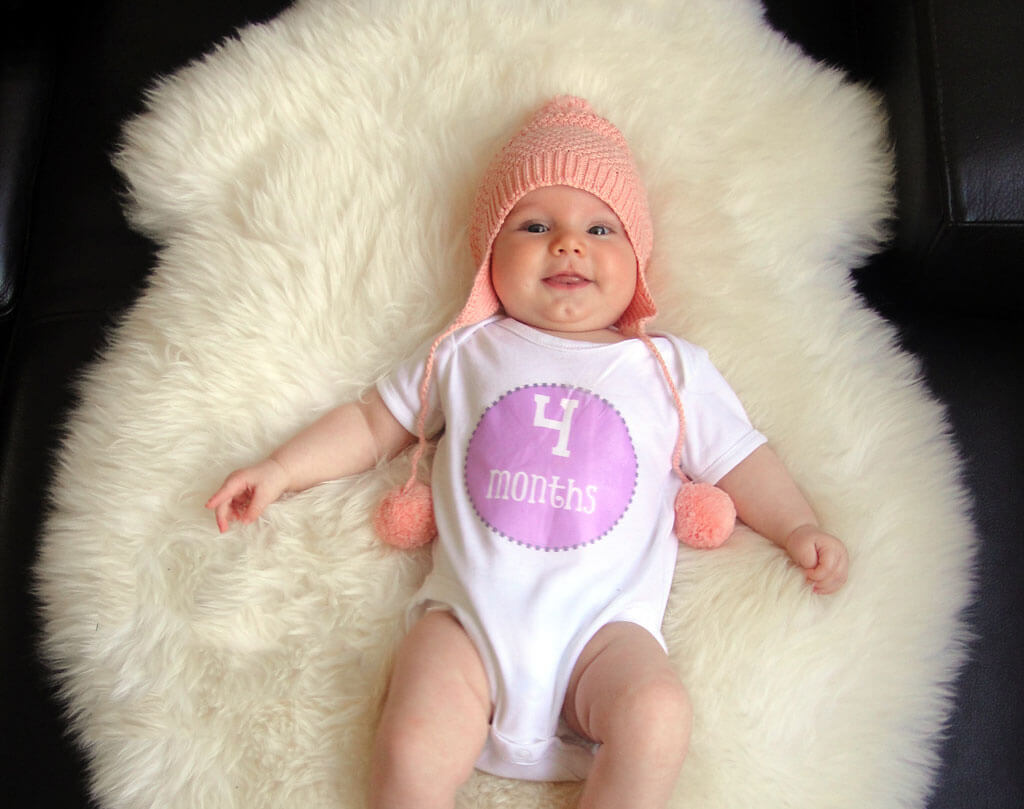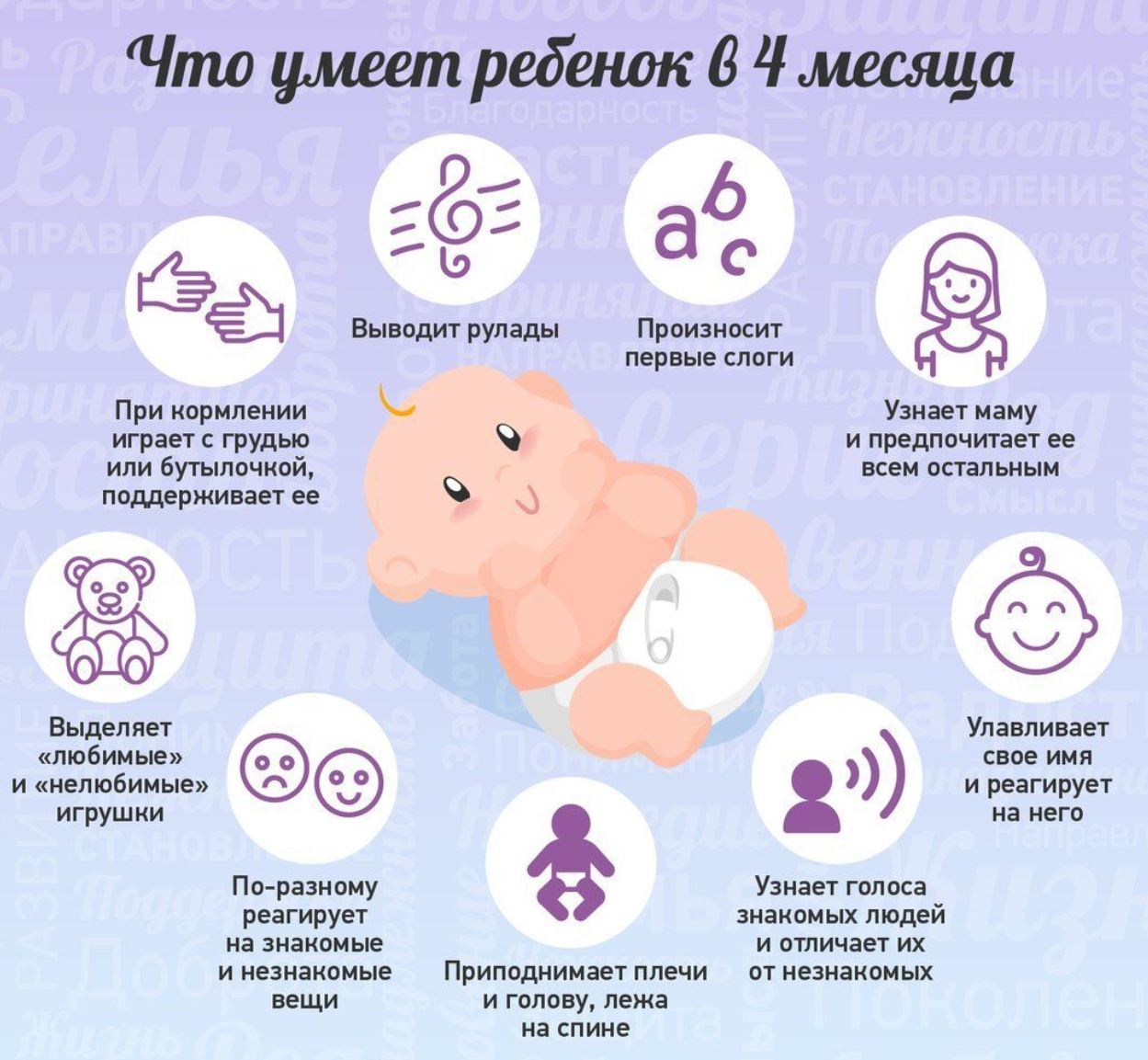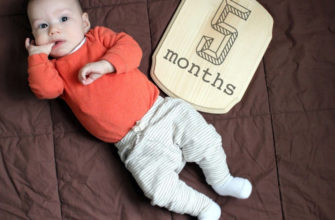A four-month-old baby is very different from a newborn. By this age, children significantly grow up in comparison with the first months after birth, change externally, physically and psychologically.

The proportions of the body vary slightly: the difference in the volume of the head and chest, which catches the eye in the first months of life, gradually decreases, the limbs become longer. In general, the proportions of the body slowly approach the proportions of an adult. In addition, by the age of four months the baby “eats up” his cheeks and turns into a glorious chubby little peanut.
New skills are emerging. The kid masters various ways of studying the world around him, begins to actively interact with him, masters new actions. All this happens against the background of improving the organs of movement, senses and the nervous system. We will talk in more detail about what a child should be able to do at 4 months.
Four month baby skills
- The child confidently holds the head;
- At four months, the grasping reflex fades and grabbing becomes conscious. This means that earlier the child reflexively clenched his fist as soon as something touched his palm, and now he squeezes the item with a pen when he wants to take it. Awareness of movements is a great progress in development, because this means that the child is already trying to learn how to control his body and coordinate movements. If we talk about grabbing, then for a child this is a new, much more complex chain of nerve impulses, the trigger of which is the child's interest in the subject. (About reflexes);
- When a child picks up an interesting object in his pen, he no longer just holds it, but tries to perform various manipulations, considers it, and pulls it in his mouth. The kid can try to knock an object, touch parts with his fingers. This is a natural and very important stage of cognition. True, in four months the coordination of movements is still very far from ideal, especially since the muscles of the hand are still poorly developed, so the child can hold something for a very short time. Can take an object of interest, shake it, put it back;
- At the age of 4 months, many babies learn not only the ability to turn from back to stomach, but also in the opposite direction. Usually, when a child has an entire set of upheavals in his arsenal, parents move the child to the floor in order to avoid falling. So much the better for the child, because in front of him is now a huge space for learning. With the help of coups, children will learn to move around the room and even get to objects of interest.(We read in detail: When the kids start rolling over);
IMPORTANT! At this age, it is important to remember that the baby learns to roll over, so it should not be left unattended. If you need to go away for a while, take care of his safety. The child can be left in the crib or on the rug on the floor. He can play on his own for about 3-4 minutes, while more of his attention is not enough. The rest of the time he really needs his mother’s hands and communication with relatives.
- Lying on his back, a four-month-old baby tries to raise his head and shoulders, as if trying to sit down. In fact, rarely, one of the children sits down from a prone position, mainly children begin to sit down, as it were, from their sides, resting on their hips. It used to be that at 4 months a baby should already be seated. Attempts to rise from a horizontal position only increase the desire to quickly seat the baby. Today, orthopedists categorically do not recommend sitting down children until they start to sit down on their own, and even more so do not offer soft pillows as a support for the baby. The support for sitting at any age should be rigid. (Read the article: When can I start to sit down children);
- The child demonstrates new skills while lying on his tummy. It's about the makings of a crawl. At 4 months, the baby knows how to lift the butt and push off with legs. Someone is really crawling in a plastopian way. By the way, for many children at first it’s easier to crawl back than forward. You can motivate the baby to crawl with your favorite toys, laid out in front of him at an accessible distance. At the same time, the baby should still be able to carry out his plan and reach for the toy, otherwise interest in such fun will quickly fade. If a palm is placed under the foot of a crumb lying on his stomach, he will push away from her and crawl forward slightly (when do children begin to crawl?);
- Innovations appear in the field of vision and hearing. If earlier the child could clearly see objects located within 50-70 cm from him, now he sees well at a distance of 3-3.5 meters. This means that the baby can easily view the room or enjoy the view from the window. Hearing also becomes more subtle. The child begins to distinguish sounds well, respond to the sounds of music, understand the emotional coloring of sounds. The most pleasant sound for the child, of course, is the mother's voice;
- Speech development is closely related to hearing. From four months the child already knows how to pronounce syllables, which are often taken for the first words. It can be the syllables "pa", "ma", "ba". With his lips, the baby is trying to reproduce the articulation of adults. Walking and babble sound more often. Especially a lot of kids "talk" when they are in a good mood. At that stage, the emotional communication of an adult with a child is very important. At 4 months, the children themselves are able to initiate this communication, urging their mother to contact with the help of smiles and their "words";
- Social development also does not stand still. The main figures in the life of the baby, no doubt, are the parents. By the age of four months, the child is already starting to distinguish “friends” and “strangers”. Moreover, even quite close relatives can fall into the category of “strangers” if the baby rarely sees them. Usually, the pean expresses his preferences by the fact that in the presence of an unfamiliar or unfamiliar person, the baby is anxious, crying, straining with the whole body. By and large, in his circle of attachments a child at this age only admits those whom he sees daily or at least every other day. The fact is that memorization and long-term memory of a little man is not very well developed, therefore for him there is only what he sees at the moment. Therefore, relatives who appear occasionally in front of a child are perceived as new people each time;
- At 4 months, babies are already well aware of all the manipulations that parents perform with them. The child can take and “give” to the mother a diaper or hat.Such actions should be encouraged, as they are useful for the further development of self-care skills.

Detailed article: Development (physical and mental) of the child in 4 months
Deviations from development standards
First of all, it is worth recalling that all children are individual. Each of them has its own pace of development, determining the physical and emotional activity of the crumbs.
However, if the lag behind peers becomes more significant, parents should show the baby to specialists. A justified cause for concern for adults should be the lack of more than half of the above skills. You should sound the alarm if, by the age of four months, the baby:
- does not show motor activity;
- independently does not hold the head;
- does not walk;
- Does not respond to your name and extraneous sounds;
- smiles rarely and completely unconsciously;
- Don't try to roll over;
- completely indifferent to toys.
At least one of these symptoms is a reason to contact a pediatrician. The doctor can immediately exclude difficult diagnoses, send for an additional examination or prescribe treatment. Fortunately, most problems at this age are successfully compensated if parents are involved in adjusting the development of their babies.
 In this article, we examined what a child should be able to do at 4 months. This set of skills is conditional for 4 months, since each child has certain “skills” that appear in accordance with their own pace of development. There are still many new discoveries and achievements, so it is better not to rush things and enjoy the gradual growing up with the baby.
In this article, we examined what a child should be able to do at 4 months. This set of skills is conditional for 4 months, since each child has certain “skills” that appear in accordance with their own pace of development. There are still many new discoveries and achievements, so it is better not to rush things and enjoy the gradual growing up with the baby.
- Last month: What can a child do at 3 months
- Next month: What a child can do at 5 months
We also read: 4-month baby day regimen
We also read: Monthly baby development calendar (month 1-12) | skills of the child in 1 year
Video: what should a child be able to do at 4 months








